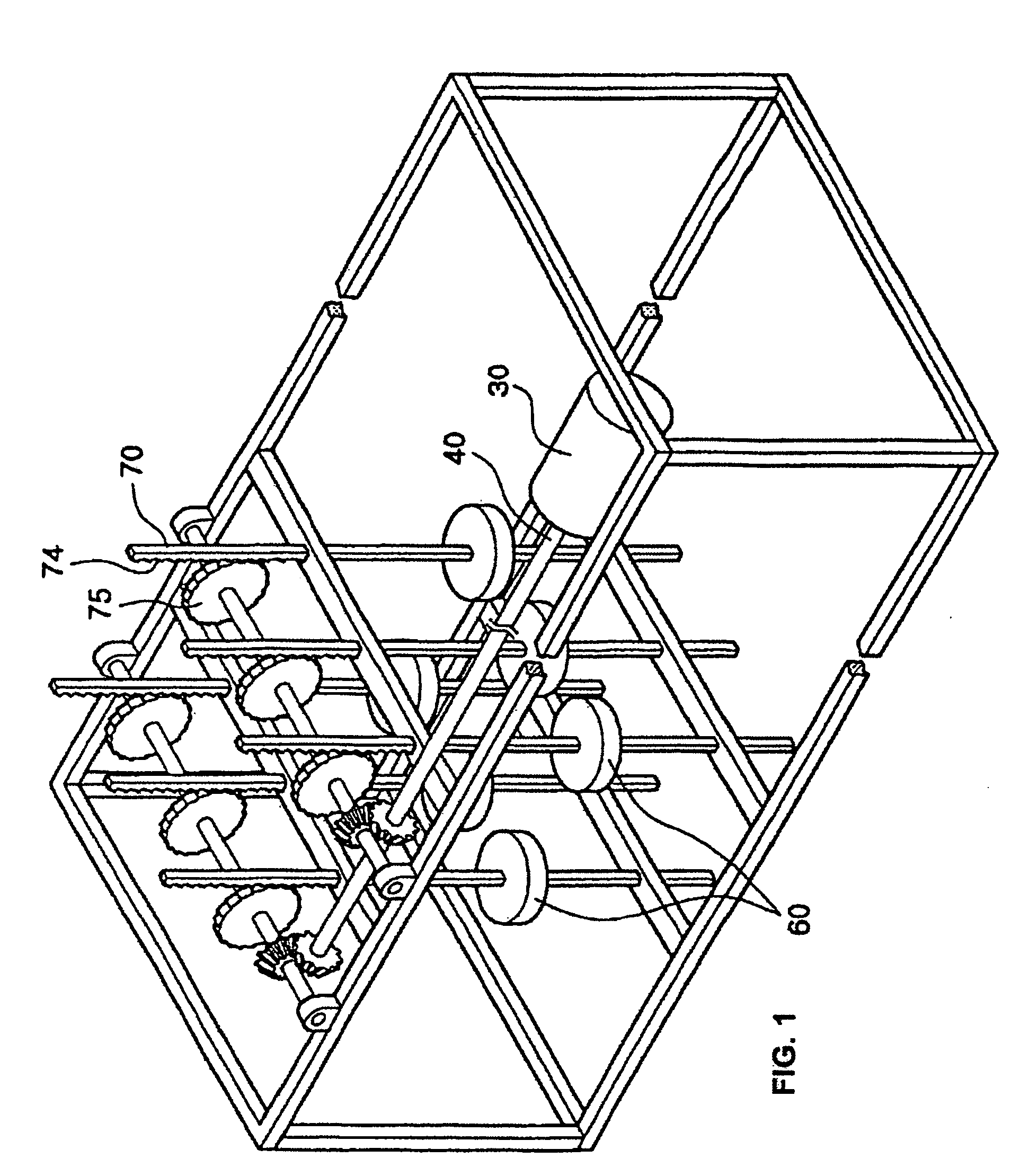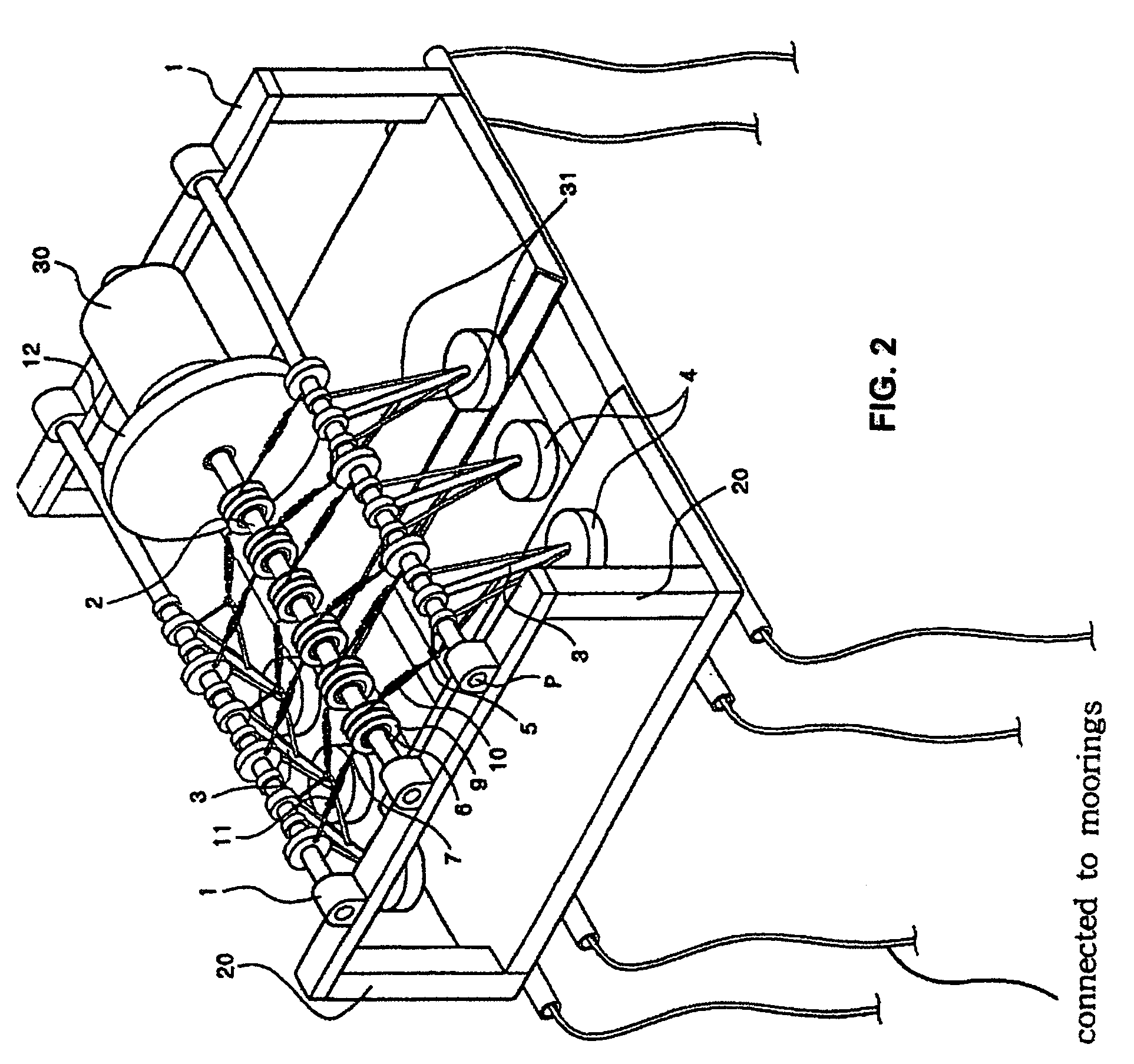Wave-power generation system
- Summary
- Abstract
- Description
- Claims
- Application Information
AI Technical Summary
Benefits of technology
Problems solved by technology
Method used
Image
Examples
first embodiment
[0024]FIGS. 2 through 4 show a wave-power generation system according to a first preferred embodiment of the present invention.
[0025] As shown in figures, the wave-power generation system of the present invention includes a stationary frame 1 for supporting various components, and a float structure 20 for floating the stationary frame 1 on the sea. The stationary frame 1 consists of relatively high-strength members engaged to each other. If the stationary frame 1 is floated on the sea together with the float structure 20, a portion of the stationary frame is exposed from the surface of the sea, while a portion of the stationary frame sinks to the sea.
[0026] The stationary frame 1 is provided with a rotary shaft 2 of a generator which is freely rotated on the stationary frame 1. A generator 30 coupled to the rotary shaft generates the power according to the rotation of the rotary shaft 2. The stationary frame 10 includes a bearing (not shown) to rotatably support the rotary shaft 2...
second embodiment
[0037]FIG. 5 shows a wave-power generation system according to a second preferred embodiment of the present invention.
[0038] Referring to FIG. 5, the wave-power generation system of the present invention includes a stationary frame 1, a float structure 20 installed to the stationary frame 1, a generator's rotary shaft 2 rotatably installed to the stationary frame 1, and a flywheel 12 installed to the rotary shaft 2, which is similar to the first embodiment.
[0039] In this embodiment, the rotary drive 9 is coupled to the rotary shaft 2 of the generator via a one-way clutch 6. One end of a two-node link 33 is coupled to the rotary drive 9, and a float 4 is installed to a free end of the two-node link 33.
[0040] A follower of the one-way clutch 6 and a first intermediate gear 71 are installed to a first rotating drive shaft 41 installed to the stationary frame 1 in a direction parallel with the rotary shaft 2 of the generator. The first intermediate gear 71 meshes with a second gear 7...
third embodiment
[0046]FIG. 6 shows a wave-power generation system according to a third preferred embodiment of the present invention.
[0047] Referring to FIG. 6, the wave-power generation system of the present invention includes a rotary shaft 2 of a generator rotatably installed to a stationary frame 1, a rotary drive 9 coupled to the rotary shaft 2 of the generator via a one-way clutch 6, a three-node link 3 rotatably installed at a point P of the stationary frame 1, a float 4 installed to one end of the three-node link 3, and a resiliently recovering member having one end coupled to the other end of the three-node link 3 and the other end coupled to a rope 5. One end of the rope 5 is coupled to the other end of the three-node link 3, and the other end is coupled to the rotary drive 9. One end of the resilient covering member is coupled to the stationary frame 1, and the other end is coupled to the rotary drive 9. The wave-power generating system also includes the rotary drive 9 coupled to the ro...
PUM
 Login to View More
Login to View More Abstract
Description
Claims
Application Information
 Login to View More
Login to View More - R&D
- Intellectual Property
- Life Sciences
- Materials
- Tech Scout
- Unparalleled Data Quality
- Higher Quality Content
- 60% Fewer Hallucinations
Browse by: Latest US Patents, China's latest patents, Technical Efficacy Thesaurus, Application Domain, Technology Topic, Popular Technical Reports.
© 2025 PatSnap. All rights reserved.Legal|Privacy policy|Modern Slavery Act Transparency Statement|Sitemap|About US| Contact US: help@patsnap.com



